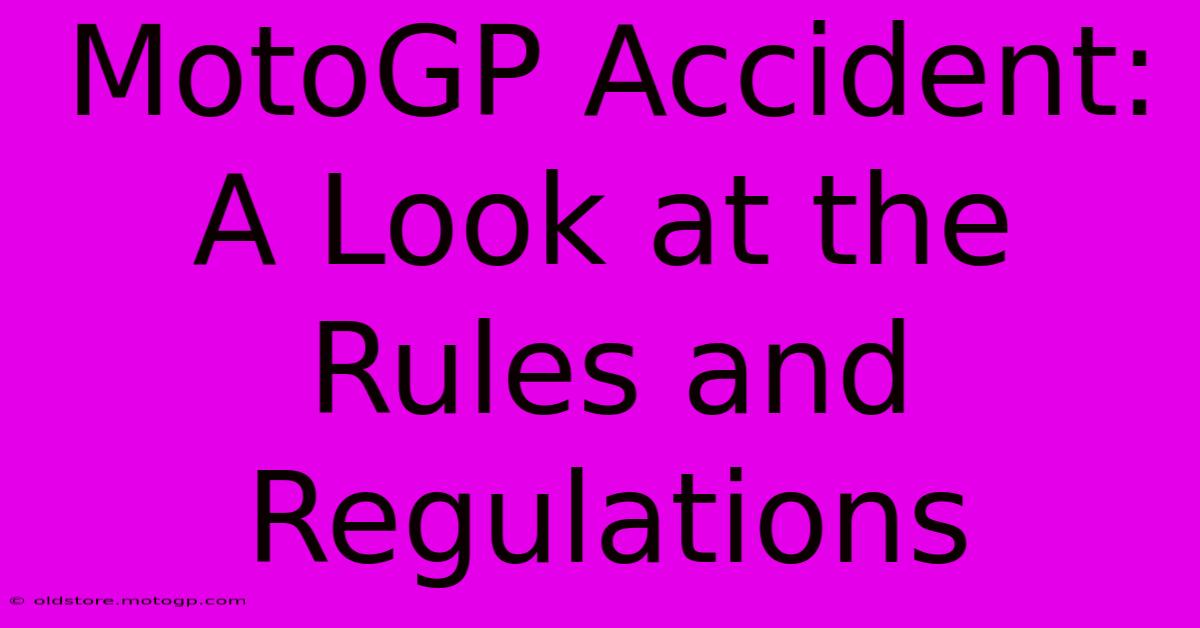MotoGP Accident: A Look At The Rules And Regulations

Table of Contents
MotoGP Accidents: A Look at the Rules and Regulations
Motorcycle racing, especially at the MotoGP level, is inherently dangerous. High speeds, aggressive maneuvers, and the unforgiving nature of tarmac contribute to the risk of accidents. While spectacular crashes are unfortunately part of the sport, the governing body, the Fédération Internationale de Motocyclisme (FIM), has implemented a comprehensive set of rules and regulations to mitigate risks and ensure rider safety. This article delves into the key aspects of these regulations concerning MotoGP accidents.
Understanding the MotoGP Safety Framework
The FIM’s safety framework is multifaceted, encompassing track design, motorcycle specifications, rider equipment, and incident response protocols. Let's break down the key elements:
1. Track Safety
- Run-off Areas: Modern MotoGP tracks feature extensive run-off areas filled with gravel or other impact-absorbing materials. These areas are designed to slow down errant bikes and prevent them from colliding with barriers or other obstacles. The size and design of these areas are strictly regulated.
- Barrier Standards: The barriers themselves are engineered to absorb impact and minimize rider injury. Technological advancements continuously improve barrier design, incorporating energy-absorbing materials and innovative structures.
- Medical Facilities: Every MotoGP track boasts state-of-the-art medical facilities, including fully equipped medical centers, ambulances, and highly trained medical personnel. Rapid response times are crucial in dealing with serious injuries.
2. Motorcycle Safety
- Technical Regulations: The FIM sets strict technical regulations for MotoGP bikes, focusing on aspects like chassis strength, fuel tank safety, and the design of vulnerable components. These regulations aim to minimize the risk of catastrophic failures that could lead to accidents.
- Safety Features: Modern MotoGP machines incorporate numerous safety features, including sophisticated electronic rider aids (like traction control and anti-lock brakes) that enhance stability and control. These technologies help riders maintain control even in challenging conditions.
3. Rider Safety Equipment
- Protective Gear: Riders are mandated to wear comprehensive protective gear, including full-body leathers, helmets conforming to strict safety standards, boots, gloves, and back protectors. This gear significantly reduces the severity of injuries in the event of a crash.
- Airbags: Many riders now employ airbag systems integrated into their racing suits. These systems inflate upon impact, providing additional protection to the rider's torso and neck.
4. Incident Management and Penalties
- Race Direction: Race direction plays a crucial role in managing incidents. They monitor the race constantly, and officials are ready to intervene immediately in case of accidents, deploying medical personnel and marshals as required. Flags and signaling systems are used to communicate with riders.
- Penalties for Causing Accidents: Riders who are deemed responsible for causing accidents can face penalties, ranging from warnings to ride-through penalties or even disqualification from the race. The severity of the penalty is assessed based on the circumstances of the incident.
The Role of Technology in Preventing MotoGP Accidents
Technology continues to play a pivotal role in enhancing safety within MotoGP. Advanced data acquisition systems record vast quantities of information during races, allowing for post-race analysis of incidents. This helps to identify potential areas for improvement in track design, motorcycle technology, and rider training.
Conclusion: A Constant Evolution
The MotoGP safety framework is a constantly evolving system. The FIM, teams, riders, and track officials are continuously working to improve safety standards. While accidents are unavoidable in this high-octane sport, the focus remains firmly on minimizing their frequency and severity, ensuring the safety of riders remains paramount. The commitment to safety innovation is what continually propels MotoGP towards a safer future.

Thank you for visiting our website wich cover about MotoGP Accident: A Look At The Rules And Regulations. We hope the information provided has been useful to you. Feel free to contact us if you have any questions or need further assistance. See you next time and dont miss to bookmark.
Featured Posts
-
A Guide To The Thrilling World Of Motorbike Racing
Feb 23, 2025
-
Cota Grandstands Where Legends Are Made
Feb 23, 2025
-
Moto 3 Motorcycle The Ultimate Lightweight Racing Machine
Feb 23, 2025
-
The Passion The Drama The Speed Tnt Sports Moto Gp
Feb 23, 2025
-
The Speed You Need F1 Shuttle
Feb 23, 2025
